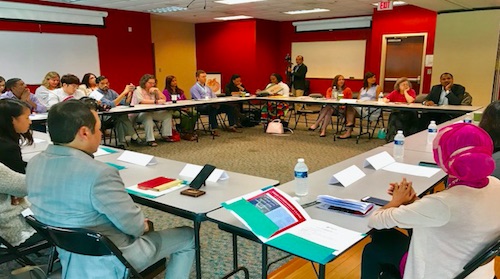In the unyielding battle against COVID-19, the unwavering persistence of the virus has become evident. The recent Ethnic Media Services (EMS) briefing, titled “It’s Very Clear: COVID is Here to Stay,” delved into the unsettling surge of COVID-19 cases, driven by the emergence of a novel variant, EG.5. Despite the conclusion of the Public Health Emergency and the easing of public health measures, the virus’s resilience remains, emphasizing the critical need for unwavering vigilance and adaptive strategies.
Rising Cases and the Intrigue of Variant EG.5:
The briefing illuminated the resurgence of COVID-19 cases, primarily propelled by the emergence of the EG.5 variant. Hospitalization rates experienced a sharp 12.5% increase nationwide in July, a concerning trend supported by data from the Centers for Disease Control and Prevention. This resurgence persists despite the lifting of the Public Health Emergency status, leading to the discontinuation of free testing and vaccines.
Delving into the intricacies of the EG.5 variant, Dr. Benjamin Neuman, Professor of Biology and Chief Virologist at the Global Health Research Complex, Texas A&M University, offered insights into its lineage and attributes. EG.5, descending from xbb 1.9 and tracing back to Ba 210 and ba 2.75, possesses distinct genetic markers. Paralleling the Omicron variant, EG.5 carries numerous mutations that set it apart from its precursor, accumulating approximately 100 to 110 genetic differences.
The variant’s heightened transmissibility hinges on changes within its receptor binding site—a focal point for vaccines and key components of the immune system. Dr. Neuman underscored the need for recalibrating vaccine strategies and formulations to effectively counter the implications posed by EG.5 and its closely related subvariants. The unequivocal message is that EG.5 and its kin pose a significant challenge to existing preventive measures, necessitating a proactive and comprehensive approach.
Vaccination Strategy and the Complexities of Adoption:
Central to the discussion was the pivotal role of vaccination in combatting the evolving virus. While the pace of vaccine development and distribution lagged behind the emergence of new variants, EG.5-focused vaccines are anticipated to bolster immunity against a broader spectrum of related strains. Dr. Neuman elucidated the intricate three-step process encompassing WHO recommendations, FDA evaluation, and CDC action—critical stages in facilitating the approval and rollout of refined vaccines.
Intriguingly, the discourse navigated the intricate issue of vaccine uptake. Despite the availability of booster shots and tailored vaccines, the briefing shed light on the underwhelming embrace of these countermeasures. This poses a formidable hurdle to achieving widespread immunity and curbing the virus’s impact.
Variants, Symptoms, and the Path Ahead:
The briefing also addressed the symptomatology associated with the EG.5 variant. Dr. Neuman clarified that while initial links between Arcturus variants and increased pink eye occurrences were observed in a small group of Indian children, such correlations lacked global consistency. The manifestation of symptoms remains somewhat unpredictable across variants, with a general trend indicating that more recent vaccinations offer better protection against severe outcomes.
Insights from Dr. Peter Chin-Hong:
The briefing progressed with insights from Dr. Peter Chin-Hong, Associate Dean for Regional Campuses at the University of California, San Francisco. His perspectives provided valuable context regarding hospitalization rates, the phenomenon of COVID-19 patients’ symptoms and recovery, and the interaction between extreme heat and COVID-19 vulnerability.
Hospitalization Rates and COVID-19 Phenomenon:
Dr. Chin-Hong elucidated the relatively stable hospitalization rates during the recent surge of infections, terming it a “gentle wave” rather than an overwhelming surge. Drawing a comparison to a year prior, he demonstrated that the current increase in hospitalizations pales in comparison to previous numbers. He attributed this increase to several factors: increased gatherings, both domestically and internationally; extreme heatwaves driving people indoors; waning immunity from earlier infections; and potentially, the EG.5 variant’s role.
Dr. Chin-Hong pointed out that the current hospitalizations are in part a result of the already widespread exposure to COVID-19. With over 95% of the population having experienced exposure or vaccination, community immunity has acted as a mitigating factor against severe disease. He also highlighted the shift in the treatment approach. Unlike earlier in the pandemic, treatments are now administered earlier in the course of the disease, contributing to lower severity.
COVID-19 Symptoms and Future Outlook:
Dr. Chin-Hong outlined the changing nature of COVID-19 symptoms among hospitalized patients. Interestingly, some patients do not exhibit classic COVID-19 symptoms, yet test positive while in the hospital for other reasons. This underscores the complexity of the virus and the variability in its presentation.
As for the future, Dr. Chin-Hong predicted a potential dual pattern: a smaller rise in cases during the summer, followed by a more substantial increase in the winter months. The combination of extreme heat driving people indoors and creating conditions conducive to virus transmission, along with the seasonality of respiratory illnesses, could contribute to this pattern.
Interaction Between Extreme Heat and COVID-19 Vulnerability:
In response to a question about whether extreme heat renders individuals more vulnerable to COVID-19 infections, Dr. Chin-Hong provided a multifaceted answer. He noted that the effect of heat itself on the body’s susceptibility to COVID-19 remains complex. However, he highlighted the human behavior aspect related to extreme heat. High temperatures often lead to people congregating indoors, which increases close contact and the likelihood of virus transmission. Additionally, the tendency to touch one’s face more frequently due to discomfort or sweat can facilitate the spread of the virus.
Air conditioning settings also play a role. Dr. Chin-Hong emphasized that the type of air conditioning system used—whether it recirculates indoor air or brings in fresh air from outside—can influence the risk of virus transmission. These factors underscore the intricate interplay between environmental conditions, human behavior, and viral transmission.
Insights from Dr. William Schaffner:
Dr. William Schaffner, an esteemed medical expert, provides valuable insights during the discussion about COVID-19 therapeutics. He begins by commending the global response to the pandemic, particularly the research community’s dedication to understanding the virus and creating diagnostics, vaccines, and therapeutic agents. He highlights the importance of this collective effort in tackling the virus’s impact.
Dr. Schaffner then delves into the specifics of available therapeutics, discussing Paxlovid and remdesivir. He underscores that Paxlovid has demonstrated efficacy in reducing severe disease risks, especially when administered to high-risk individuals promptly after infection. However, he acknowledges that like any therapeutic, Paxlovid has its limitations, such as potential drug interactions and dosing challenges.
Turning his attention to remdesivir, Dr. Schaffner recognizes its role in hospital settings but stresses the need for additional therapeutics aimed at preventing hospitalizations. He expresses a desire for a broader arsenal of treatments that can keep individuals out of the hospital and contribute to better management of the disease.
Dr. Schaffner also addresses ongoing research efforts to develop new therapeutic agents for COVID-19. He acknowledges that these efforts are continuing but refrains from speculating on when these treatments might become available. Despite the uncertainties, he emphasizes the research community’s dedication to contributing to global COVID-19 control.
Equitable access to therapeutics and vaccines is a critical concern for Dr. Schaffner. He recognizes the challenges associated with ensuring that these treatments are available to all individuals, especially those from marginalized communities. He underscores that disparities in healthcare access remain an ongoing issue that needs to be addressed as the world navigates the pandemic and its aftermath.
When the topic of “Paxlovid rebound” arises, Dr. Schaffner provides a balanced perspective. He notes that while rebound isn’t experienced universally, a significant proportion of patients have reported some form of rebound. He clarifies that the available data on infectiousness during the rebound period is incomplete, suggesting that during this time, infectiousness might be reduced. However, he invites input from his fellow experts, indicating his openness to collaborative insights.
Conclusion:
The EMS briefing reiterated the relentless nature of the COVID-19 pandemic and the ongoing need for public health vigilance, especially in the face of new variants like EG.5. Experts underscored the significance of updated vaccines to counter these evolving strains. However, the challenge lies not only in vaccine development but also in ensuring widespread acceptance and adoption of these measures.
As the pandemic continues to evolve, the briefing serves as a reminder that proactive adaptation, rigorous research, and effective communication are essential in mitigating the virus’s impact and safeguarding public health. Dr. Peter Chin-Hong and Dr. William Schaffner’s insights further enriched the discussion, providing deeper context and perspective on hospitalization rates, symptomatology, therapeutic strategies, and the intricate relationship between environmental factors and disease vulnerability. As the world navigates this ongoing crisis, informed dialogues such as this briefing contribute significantly to our collective understanding and response.
#COVID19 #EG5Variant #VaccinationStrategies #RisingCases #Resurgence











